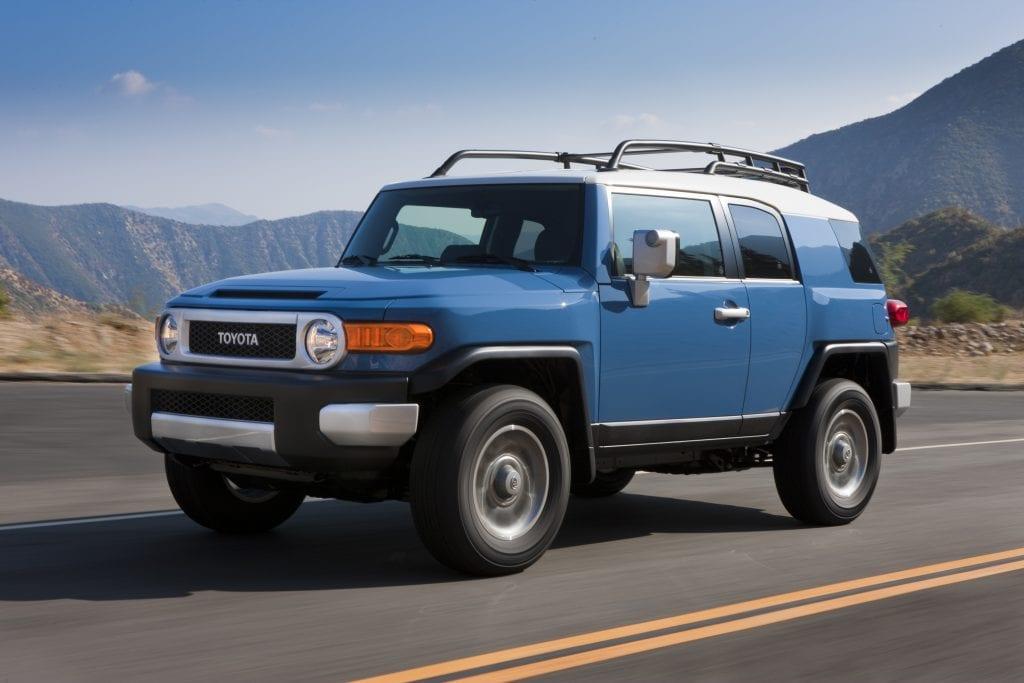The Toyota FJ Cruiser is a Used Car Hidden Gem
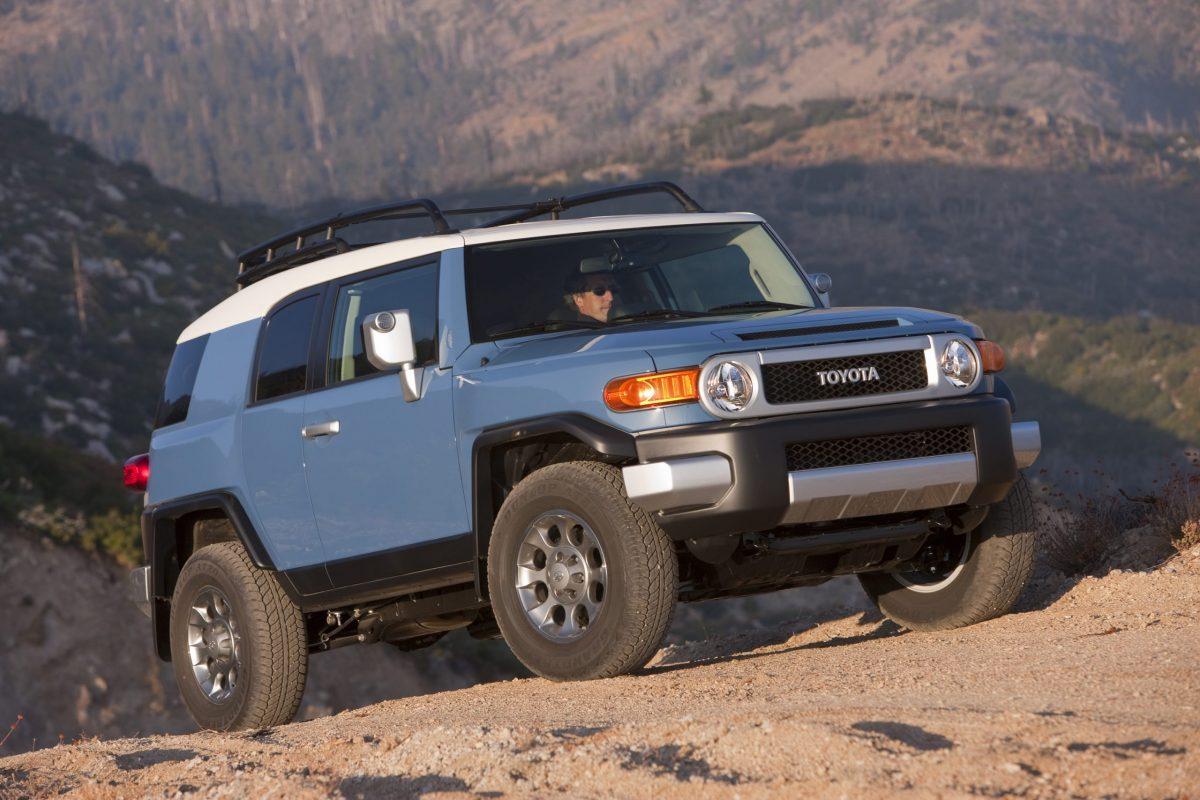
Contents
The FJ Cruiser began life purely as a design concept. It’s retro lines — penned by then 25-year-old Jin Won Kim of Toyota’s Calty design studio in Newport Beach — recall many elements of Toyota’s iconic FJ40, the original Land Cruiser.
Even though Kim was born a quarter century after the original FJ rolled off the assembly line, he nailed the look. In fact, it wowed people so much at its 2003 debut at North American International Auto Show in Detroit that Toyota greenlit the FJ Cruiser for production.
Three years later, a new icon was born.
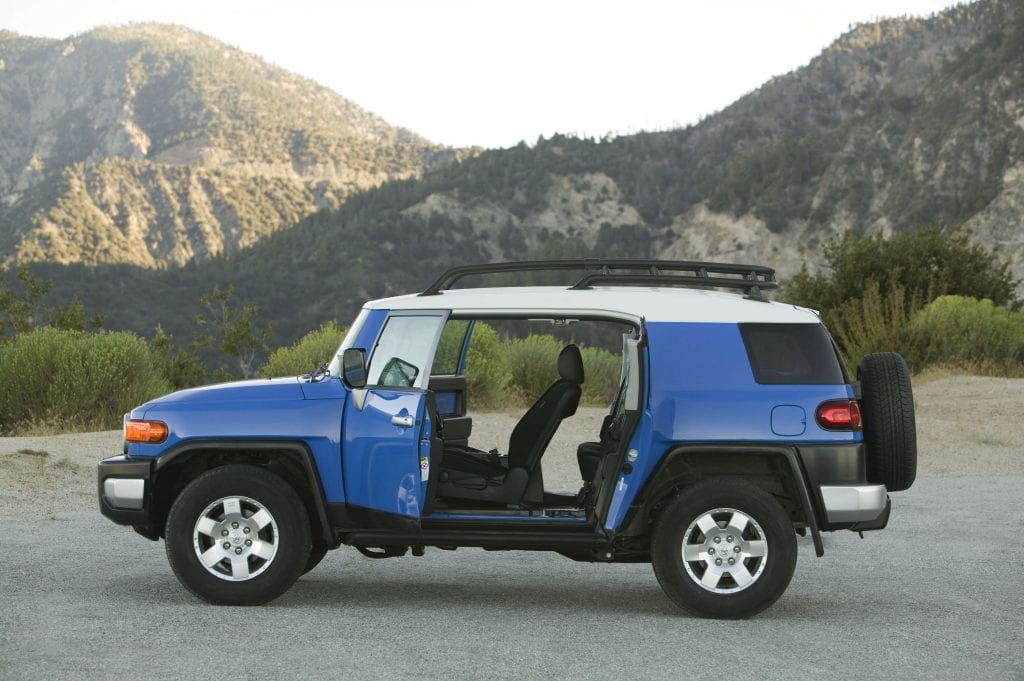
Introduction
Toyota first brought the FJ Cruiser to market in 2006 (as a 2007 model) and produced it for seven model years (2007 through 2014). The exterior was little changed from Kim’s stylish concept, while the chassis and running gear were based largely on Toyota’s Land Cruiser Prado and 4runner models, both highly accomplished off-roaders. That means heavy duty body-on-frame construction, a solid rear axle, and a 4.0 liter V6 workhorse under the hood.
Buyers had the choice of three powertrains, all based on the 239 hp V6 (engine code 1GR-FE). Most commonly paired with it was a 5-speed automatic transmission, sending power to all four corners through a part-time four-wheel drive system. This setup was also available in rear-wheel drive only, though few opted for it. A 6-speed manual gearbox was offered as well, featuring full-time four-wheel drive. In 2010, the V6 got a performance upgrade, with smarter variable valve timing (VVT-i) boosting horsepower to 258 and increasing fuel efficiency from 17 mpg to 18 mpg (combined).
With ample ground clearance, a long-travel suspension, and short overhangs, the FJ Cruiser offers impressive off-roading capabilities, especially in 4×4 spec, with a locking center differential, available active traction control (dubbed “A-TRAC”), and the option of a locking rear diff. Toyota called the FJ Cruiser “the most capable 4X4” in its lineup at the time. Put it in low range, and you can go pretty much anywhere four wheels will take you. As a bonus, it’s also capable of towing up to 5000 lbs.
As you might expect, the FJ Cruiser’s off-road prowess takes a bit of a toll on the tarmac. Reviewers of the day complained of excessive body roll in corners, a rough ride over broken pavement, as well as a meager 0.7 g of grip on the skidpad. In a 2009 test, a Car and Driver called its on-road performance “boat-like.” That said, it’s certainly far more comfortable and refined on the asphalt than the original FJ40 could ever hope to be.
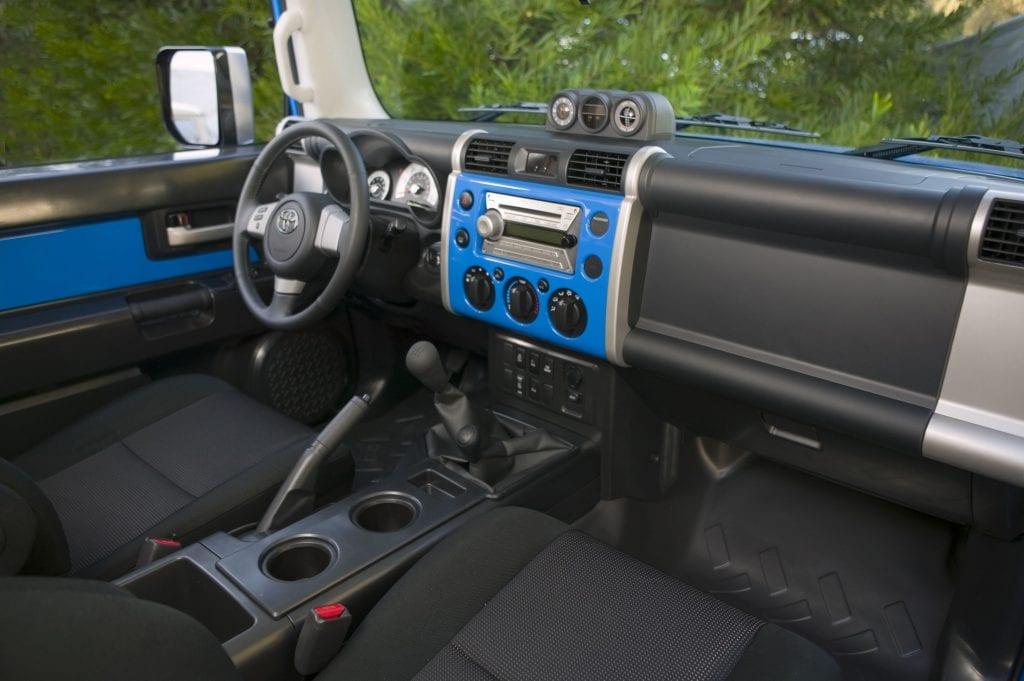
Features and Options
Inside the FJ Cruiser, you’ll find room for five (in a pinch), with access to the rear seats via unusual clamshell doors. Styling seems to come from the Lego school of design, with a chunky, utilitarian look that can be polarizing (for the record, we like it). Split-folding rear seats offer as much as 66.8 cubic feet of cargo capacity. The FJ Cruiser even sports rubber floor mats instead of carpeting, in case you need to hose things off after an afternoon of mudding.
Basic creature comforts like AC, a six-speaker stereo, power windows and door locks, and a manually-adjustable driver’s seat are all standard. An optional “Convenience” package provides cruise control, keyless entry, power mirrors, tinted glass, plus rear parking assistance, which is nice to have because the SUV’s thick C pillars limit visibility. Other available upgrades include alloy wheels (steelies were standard), a handy 115-volt power outlet in the cargo area, as well as an extra set of gauges atop the dash to display outside temperature, compass heading, and incline angle.
For serious off-roaders, Toyota bundles 16-inch alloys with fat 75-series all-terrain tires, trail-tuned Bilstein dampers, A-TRAC traction control, and the locking rear differential into the “All-Terrain” package (also known as the “Off-Road” package). And CRAWL control — which utilizes the vehicle’s sensors and computers to maximize low-speed traction over difficult terrain — appears for the final two years (2013 and 2014) on FJ Cruisers equipped with an automatic transmission and the All-Terrain package or the Trail Teams package (see Special Editions below).
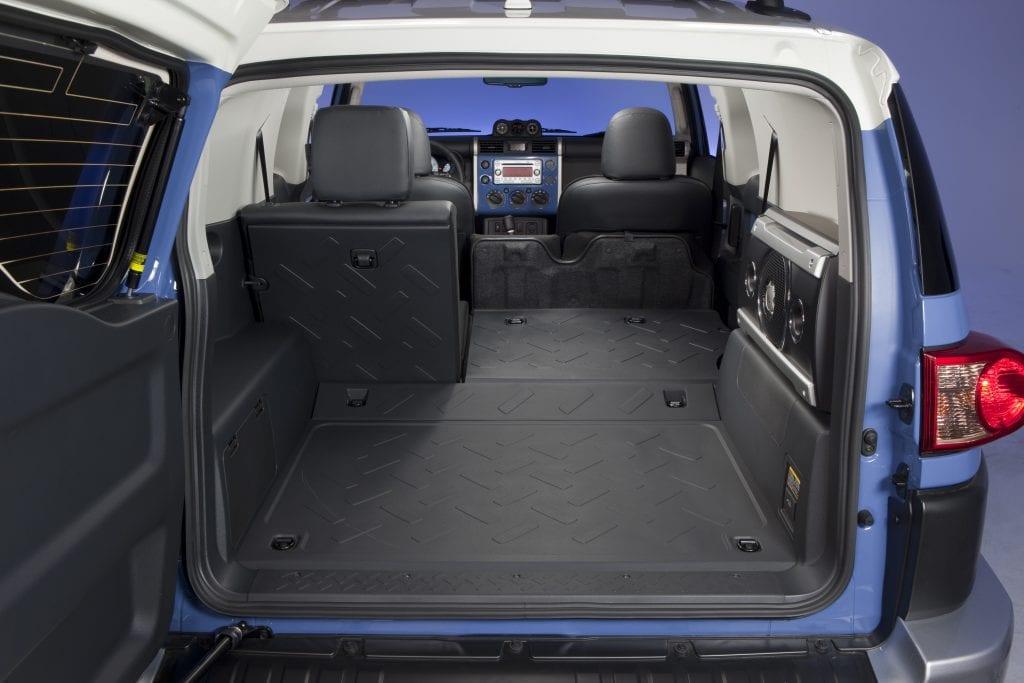
Alternatively, an “Upgrade” package offers a slightly more suburban setup, with most of the same off-road hardware (minus the Bilsteins) but on larger 17-inch wheels with lower-profile 70-series tires. It also adds luxuries like a leather-wrapped steering wheel, rear parking assist, and a better stereo. For a comprehensive list of available options and packages year by year, check out this link.
On the safety front, the FJ Cruiser is well equipped for the era, with anti-lock brakes (ABS), stability control, and front airbags standard. Side curtain airbags were optional for 2007 but made standard for 2008 and later model years. The Insurance Institute for Highway Safety (IIHS) named the 2009 FJ Cruiser a Top Safety Pick, and other model years generally fair well in safety testing.
Special Editions
Toyota offered a limited-production version of the FJ Cruiser for almost every year it was produced. These special editions combine all of the goodies from the All-Terrain package — like beefier suspension components, factory rock rails, alloy wheels with more aggressive all-terrain tires, plus A-TRAC traction control and the locking rear diff — with distinctive styling elements, like unique paint colors and wheel treatments.
For 2007, this version was badged as the TRD Special Edition and limited to 3200 units. It’s distinguished by an all-black color scheme (vs. standard models which have a white roof) and 16-inch alloy wheels finished in gunmetal grey, plus TRD badging inside and out.

The following year, Toyota changed the name to the Trail Teams Edition. The 2008 version (pictured above) can be identified by its all-white (Iceberg) paint, which is offset by blacked-out trim and black wheels. Inside, it features matching white panels on the doors and dash, plus aluminum gear shift knobs. Production was again limited to just 3200 examples.
There was no Trail Teams Edition for 2009, but it returned for the 2010 model year in Sandstorm beige with all-black trim, black-and-silver beadlock wheels, plus a new blacked-out hood. The interior again features color-matching beige panels and is further distinguished with matching beige front seat inserts, too. This is the rarest special edition of the bunch, with production capped at 1500.
The 2011 Trail Teams Edition sports Army Green paint against black trim and wheels, with matching green inside on the doors, dash, and seats. We think this is the handsomest version of all. Twenty-five hundred were made.

The 2012 Trail Teams Edition (pictured above) stands out with its Radiant Red paint scheme against black trim and wheels. Like the others, it features matching inserts on the door panels, dash, and seats — plus, for the first time, on the steering wheel, too. This would be the only special edition to offer color-matched accents on the wheel. Toyota produced 2500 units.
For 2013, the Trail Teams Edition appears in Cement Gray with black trim. Black-and-silver beadlock wheels make a return appearance for the first time since 2010. And for the first time ever, special edition FJs with an automatic transmission now benefit from Toyota’s CRAWL control feature. Inside, the black-and-gray theme continues, and the shifter knobs are upgraded to black aluminum (from black plastic). Production is again limited to 2500.
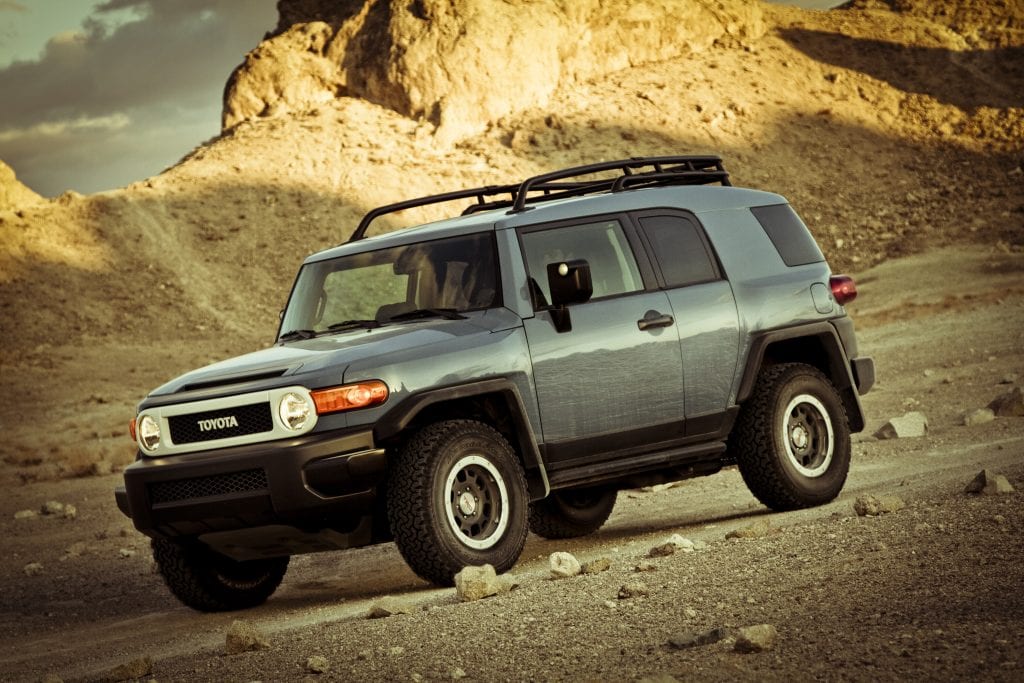
For the final year of the FJ Cruiser, the Trail Teams Edition becomes the Trail Teams Ultimate Edition (pictured above). Its Heritage Blue paint scheme calls back an early FJ40 color, and rather than featuring completely blacked-out trim, the front grille bezel and “Toyota” lettering remain white in homage to the original FJ. The Ultimate Edition also features one-year-only upgrades like an aluminum skid plate and more robust TRD springs and shocks. Where other special editions offer color-matched panels throughout the interior, the 2014 version is mostly black inside with contrasting silver inserts on the dash and front seats only. Capping it off is an aluminum plaque affixed to the dash, noting “Ultimate Edition: Limited Production One of 2,500.”
Problem Areas
The FJ Cruiser offers excellent reliability overall, as you would expect from Toyota. But there are a few problem areas to be aware of.
Rear Differential Failure
The earliest FJ Cruisers — specifically those that rolled out of the factory before January 2007 — can suffer from premature failure of the rear differential. The primary symptom of this issue is whining and clunking coming from the rear end. Fortunately, most early examples will have had this issue addressed by now, usually under the factory warranty. But if you’re looking at a 2007 model, you’ll want to check the build date (shown on the VIN sticker in the driver’s side door jamb) and/or the service records just to make sure.
Fender Bulging
FJ Cruisers prior to the 2010 model year have a known weakness in the front fenders, which can result in bulges, cracks, and even tears in the metal. You can usually spot an affected example by opening the hood and examining the inside of the fender on each side. By most accounts, this issue mainly affects models built before February 2007. However, Toyota did not offer a fully redesigned fender until the 2010 model year.
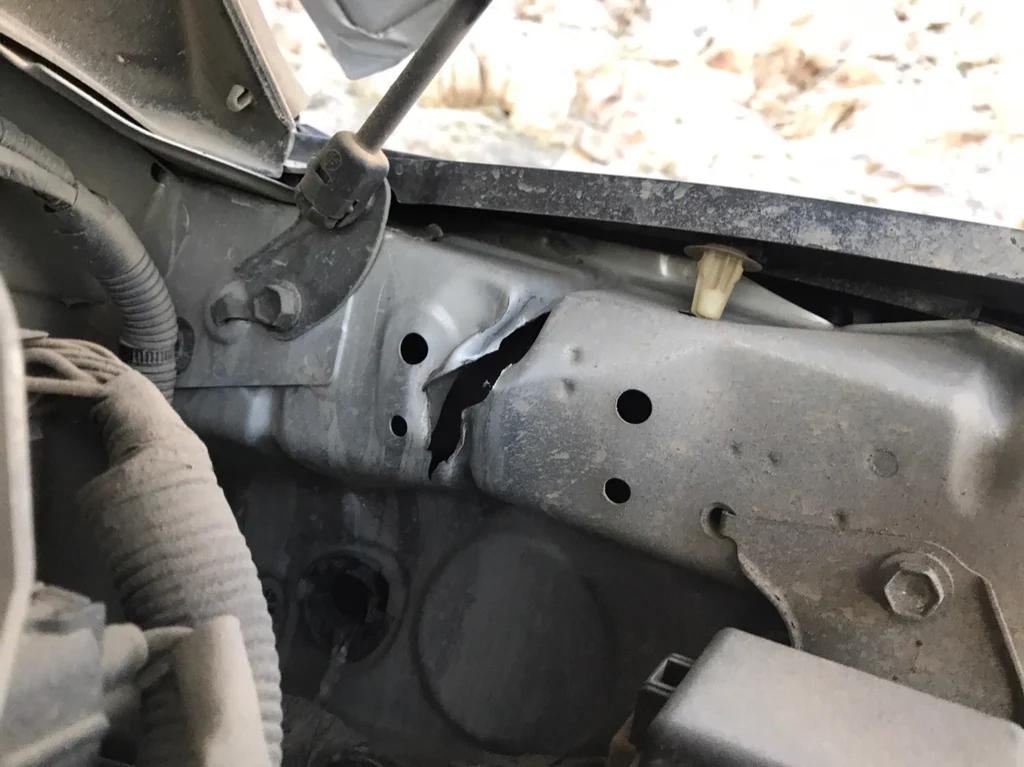
Unfortunately, there’s not really an easy fix for fender bulges or tears (pictured above, courtesy of fjcforums.com). Some owners have reinforced the areas with additional welds or plates, though others have left them as is and report no significant impacts to the vehicle’s performance.
Still, we advise steering clear of any examples with evidence of fender bulging. While the issue may not affect everyday performance, a significant breach in the vehicle’s structure can compromise its ability to protect passengers in the case of a severe accident. That’s not a risk worth taking.
To avoid this issue entirely, stick to 2010 or later models.
Pre-purchase Inspections (PPIs)
Before you spend $15,000 or more on a used FJ Cruiser, we highly recommend hiring a Toyota specialist to evaluate it. For about $250, they’ll provide you with a thorough inspection of the entire car. This can reveal major, deal-breaking issues, like hidden damage from an accident, or minor things that you can use as bargaining points, like worn brake pads. Either way, it’s easily worth the money to complete a professional inspection prior to finalizing any used car purchase.
To learn more about finding a good local mechanic, check out our article, How to Find a Good Auto Mechanic That You Can Trust.
Buying Tips
In a recent search on Autotrader, we found just shy of 1000 used FJ Cruisers for sale nationwide. Prices range from a low of $7795 for a 2008 example with a staggering 518,461 miles (in case you were still wondering whether these can go the distance, there’s your answer!) to an eye-popping high of $84,900 for a final-year Trail Teams Ultimate Edition with just 915 miles and a rare manual transmission. For reference, that’s more than double its original sticker price.
Of course, most fall into a much narrower price band. Actually, two bands. First are the early model years (2007 and 2008), which make up about half of all FJ Cruisers out there, thanks to waning demand after a couple of years of strong initial sales. Since these early years are both the oldest and the most common, they are also the cheapest. You can find nice examples with fewer than 150,000 miles for about $15,000 to $20,000. Another five grand adds much lower-mileage early FJs to the mix. We found quite a few 2007-2009 models for sale in the $20,000 to $25,000 range with under 75,000 miles on the odometer.
And that brings us to the second price band. Because of the improvements that Toyota made to the FJ Cruiser over the years, including a notable bump in power starting in 2010, plus their relative rarity compared to 2007-2008 models, examples from 2010 and later generally sell for quite a bit more. Prices start around $25,000 for 2010 and newer FJ Cruisers in great shape with around 125,000 miles on the clock. They quickly climb to $40,000 as the miles drop and equipment levels rise. But unless you’re looking for a real garage queen, you should be able to find one of the nicest FJs out there for under $35,000.
You can pay more, for sure. The price for a low-mileage (under 50k) special edition is generally about $45,000. And when the miles get super low (under 15k), the asks tend to head north of $50,000. This is collector car territory. If you’re planning to actually drive your FJ Cruiser, there’s no need to fork over that kind of money.
One other note. If you’re looking for an FJ Cruiser with a manual transmission, you may have to be patient because only about 15% were equipped with three pedals.
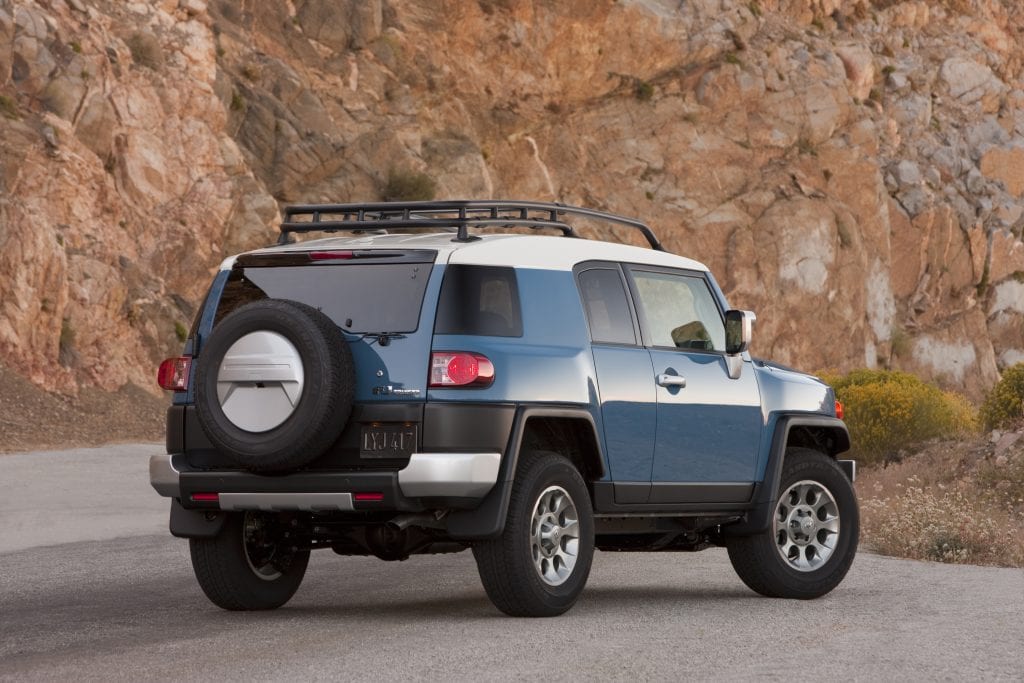
The Bottom Line
The FJ Cruiser is a worthy heir to the FJ name. Like the original FJ40 it pays homage to, it’s a practical, durable, and highly-capable off-roader. But unlike its forebears, it’s also quite civilized when it needs to be. That makes it a pleasure to drive, both on-road and off.
It’s no surprise then that the FJ Cruiser has enjoyed some of the highest resale values known in the industry. As late as 2019, it was given the #1 Best Resale Value Award by Kelley Blue Book for holding a remarkable 70% of its original value (on average) five years after leaving the showroom floor.
Unless Toyota decides to start selling brand-new FJ Cruisers again, that trend is unlikely to change.
Photos courtesy of Toyota
